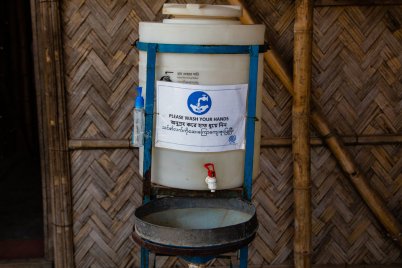
“The whole thing about TB is you just don’t know how you got it,” says 54-year old Amina Scully, a London resident and recent survivor of tuberculosis.
Scully developed symptoms of tuberculosis (TB) in 2014 when she returned to London after a decade living on the sunny shores of Spain. Despite years of fresh food and air for both she and her children, she developed the disease.
Now, almost one year after completing her treatment, one question remains unanswered in her mind – how did she get it? Scully has no idea how, or where, she picked up the bacterium behind it, Mycobacterium tuberculosis. This inability to place that crucial moment is the same for millions with TB worldwide.
Despite what many believe, TB continues to affect – and kill – millions of people across the globe. In 2014, 9.6 million people were estimated to have fallen ill with TB worldwide, and the disease killed 1.4 million, according to the World Health Organization (WHO). As Scully can testify, it doesn’t just strike in developing countries.
“I walked into the TB clinic and there wasn’t enough seating. It was absolutely packed with everybody from everywhere and I asked the receptionist ‘Have all these people got TB’?” says Scully . The answer was a resounding “yes”.
A report by the London Assembly in 2015 revealed that certain boroughs in London had rates of TB as high as 113 per 100,000 people. These levels are higher than that of China, Brazil and the Russian Federation, which are among the 22 highest burden countries in the world for TB. “I didn’t know it was so common in London,” says Scully .
TB is a complicated disease. The bacteria behind it have the ability to infect multiple parts of the body, not just the lungs. Scully developed a rare form of the disease, which infected her spine, known as extrapulmonary TB. The lack of infection in her lungs meant she wasn’t infectious to others, but its complexity meant a longer treatment period for over a year.
London is a hotspot for TB, showcased by the fact that rates in the UK as a whole are just 3%. More than 80% of cases in London occur in people who were born abroad and are likely carrying latent infections yet to manifest.
The millions unaware they have TB
“Somebody can remain latently infected for 10-20 years before they develop the disease, it’s not something you can quickly pick up, treat and prevent ongoing transmission,” explains Dr Helen Fletcher, Director of the TB Centre at the London School of Hygiene & Tropical Medicine. This is one of the key challenges of controlling the epidemic.
One third of the world’s population is estimated to be latently infected (though recent studies suggest this figure is likely to be lower), and only 10% of those infected will develop the disease. “It’s the nature of the disease…a silent pathogen that can stay in a community for a long time bubbling on in the background,” explains Dr Fletcher. This leaves a pool of millions carrying the bacteria globally, which may or may never take hold.
“Somebody can remain latently infected for 10-20 years. It’s the nature of the disease…a silent pathogen that can stay in a community for a long time bubbling on in the background.”
Dr Helen Fletcher, Director, TB Centre, London School of Hygiene & Tropical Medicine
“TB is now the biggest single infectious disease killer in the world,” says Dr Fletcher. This title was bestowed upon the disease in 2015, overtaking HIV/AIDS.
This rise in fatality status, along with the culmination of the millennium development goals (MDGs), led to grand changes in the field of TB control through the announcement of an ambitious plan to tackle the millennia-old disease once and for all – the End TB strategy.
It would be the beginning of the end, within twenty years.
The end of TB?
Rates of TB globally have been declining at a meagre rate of 1.5% per year since 2000, making rates 18% lower today than at the start of this century. Whilst certain regions of the world have slowly eliminated the disease, the burden in others has grown. Absolute numbers of people infected remain high in India and China, where population sizes are the highest in the world. Another region has become an epicentre based on actual rates of infection found there: sub-Saharan Africa, fuelled by HIV lurking in the background.
Whilst the MDG to reverse the number of new infections was achieved, this was not enough. The new strategy to end TB takes things much further with the plan to wipe out the epidemic once and for all by 2035.
“The targets are very ambitious, but with no ambition, there would be no progress,” says Dr Mario Raviglione, Director of the Global Tuberculosis Programme at the WHO.
The overarching strategy is to boost the decline in rates to 10% per year until 2015, and then further to 17% until 2035. This end goal is a 50% reduction in rates of TB by 2025 and, more ambitiously, a 90% reduction by 2035.
“If measures are effectively implemented…the global targets could be reached,” admits Dr Raviglione However, the measures required are extensive and ambitious.
Setting the goals, and measures, involved wide-scale consultation with national programmes, governmental institutions, civil society organizations, NGOs, academics, activists, and research institutions – including researchers at the School’s TB Centre. The essence underlying the strategy was to improve the use of tools available today, then further accelerate control efforts by the, hopeful, arrival of a crucial new weapon.
The ultimate tool? A vaccine. The vaccine needed for TB, however, is not the usual kind.
“If we want to reach the 2035 goals we need to start thinking about developing vaccines for use in adults who are already infected with TB rather than the traditional approach developing vaccines that are used in children,” says Dr Richard White, Reader in Infectious Disease Modelling and Director of the TB Modelling Group at the School. His team use data to mathematically model and predict the outcome of various interventions, including a vaccine.
Preventative vaccines developed for children are important, but to reach the new goals and truly end TB, the key is to remove the bacteria from the pools of people carrying it worldwide. “Globally most infectious TB develops primarily in adults and if we focus just on today’s kids, it will take longer than 2035 to have a substantial effect,” explains Dr White. This requires a post-infection vaccine instead.
Dr White’s team was asked by WHO to model the impact of a range of new vaccine approaches and outcomes. “WHO wanted to see the effect of a 60% efficacy vaccine at varying coverage,” he says. A vaccine protecting at least 60% of those receiving it should be enough to reach the goals to end TB.
The road to getting such a vaccine, however, has been filled with obstacles. “The immunology of human beings and their relationship with TB is fascinatingly complex,” explains Dr White. As a result, the vaccines developed to date have failed to show enough of a protective effect. Today, Dr Fletcher is on the case.
“I’m focused on really looking at why TB vaccine fail…why do we develop candidates that look great in early trial and then go on and fail in TB endemic populations?” asks Dr Fletcher. She’s not letting a few hurdles get in her way.
The trials and tribulations of a TB vaccine
There is a vaccine against TB already…isn’t there? This is the general consensus around the world, notably among people who don’t work in the field of TB. Such thoughts are not necessarily untrue, but the detail understood to be true may be outdated.
“You get this jab at school when you’re younger which is supposed to stop TB coming into your life… ever,” says Scully, who had believed her,self to be immune against the disease until she contracted it. “I didn’t realise this wasn’t true,” she says.
The “jab” she refers to is the Bacillus Calmette-Guérin vaccine, known more widely as BCG. Developed in 1921, the vaccine was originally made for use against Bovine tuberculosis in cattle, but became a routine vaccine administered among adolescents across the world. In more recent years, the extent of its protection has come into question.
“BCG is extremely effective in some populations,” explains Dr Fletcher. It remains the only preventative weapon against the disease, but only in certain age groups and populations and only against certain forms of the disease. BCG does protect infants from TB if given soon after birth, says Dr Fletcher. Interestingly, the vaccine also protects against a related bacterial species, Mycobacterium leprae, which causes leprosy.
Protection is also limited to specific subsets of the world’s population. “As you move further away from the Equator, or to people who haven’t been previously exposed to TB, it can protect with efficacies of up to 80% against pulmonary infection,” said Dr Fletcher. Unfortunately, this doesn’t embody the countries with the highest rates of TB that are instead found near, or on, the equator and where the people at risk have often already been exposed to the bacteria.
An important point is that BCG isn’t preventing a key goal of a vaccine – transmission. “It doesn’t seem to work against adult pulmonary tuberculosis in many parts of the world, and adults who are coughing are the people who are transmitting the organism and causing new infection,” explains Dr Fletcher.
So the disease lives on.
The largest trial to date of a vaccine against TB was designed to boost the protective effect of the BCG. Based on its use of a modified Vaccinia Ankara virus it was known as MVA85A, and trialled over three years in the Western Cape of South Africa. “Infants in the Western Cape of SA have the highest non-HIV related incidence of TB disease in the world,” says Dr Fletcher. The country itself continues to have among the highest rates of TB in the world, with 834 new infections per 100,000 in 2014.
Once the trial ended, MVA85A showed little protection, with just 17% efficacy. Rather than accept defeat, Dr Fletcher is trying to understand why this happened. “It may be that the infants were too young and the immune response wasn’t ready to be effective or…maybe something in the environment which affected or impacted how MVA85A worked,” she ponders. For now, the reasons remain a mystery.
“The current knowledge of immunology and pathophysiology of TB is still insufficient to allow the design of such an effective vaccine,” says Dr Raviglione. WHO support the investigative, problem-solving, research conducted by researchers like Dr Fletcher who are trying to get to the bottom of the problem. “Basic research is a must to understand better how the organism needs to be tackled and the host response stimulated,” he says.
The challenge comes down to the immune response itself.
“If you look at the vaccines which are used today, all of those vaccines protect via the induction of an antibody response…TB is effectively silent in terms of an antibody response,” says Dr Fletcher. This is caused by the fact that when TB enters the body, it enters the body’s macrophage cells within the immune system and stays there in hiding. Diseases such as HIV and malaria involve similar processes where the virus, or parasite, is hidden away inside cells and able to avoid immune attack. This explains the long road these three diseases have taken to develop a powerful vaccine.
The response needed to attack comes from another component of our immune system, known as T-cells, which are able to attack and kill any cells they deem to be infected. These form the body’s innate immunity. The challenge is initiating their attack. “The main challenge is to provide the different levels of signals required for activation,” says Dr Fletcher.
The clock is ticking but Dr Fletcher is setting the foundation for delivery of vaccine in 10 years. “By learning from that trial (MVA85A) about the immunology…we can now, today, start using that for vaccine development,” says Dr Fletcher.
“We really need something by 2025.”
In the meantime….
The fact remains that until the aspirational vaccine arrives, a lot more needs to be done to reach the target for 2025 – bringing numbers down by 50%.
“The vaccine work being done here is a long game…for the time being we are looking at controlling other components of the epidemic,” says Dr David Moore, Professor of Infectious Diseases and Tropical Medicine at the School. Dr Moore is tackling many of them one by one.
To truly reduce the number of new infections, one key goal is to stop people spreading their infections. “Patients, once diagnosed with TB, shouldn’t be infectious for particularly long after…most of the infectious period pre-dates the diagnosis,” says Dr Moore. The key therefore is finding, and diagnosing, people earlier either by encouraging them to seek treatment earlier – or go out and find them yourself.
This involves teams going out into endemic areas and looking for people infected with TB and includes the household contacts of patients themselves, even if they’re not showing signs of the disease.
“If we want to reach the 2035 goals we need to start thinking about developing vaccines for use in adults who are already infected with TB rather than the traditional approach developing vaccines that are used in children.”
Dr Richard White, Reader in Infectious Disease Modelling, London School of Hygiene & Tropical Medicine
“The question is what should we do with contacts who are not currently ill?” asks Dr Moore. Options are to give these people a key drug used to treat regular forms of TB, called isoniazid. This can be taken as a preventative therapy and in turn reduce the pool of latently infected people whose infections remain unbeknownst to them.
“With the new END TB Strategy, treating latent infection has become much more centre stage,” says Dr Moore. However, finding, and treating, them is no easy feat.
The main test used to identify the presence of infection is the tuberculin skin test (TST). This uses a protein component of the bacteria to test for an immune reaction against it, implying previous exposure and infection. But the test has limitations. Anyone who received a BCG vaccine, or is infected with other forms of mycobacterium, may have a reaction. “The test only tells us about the immunological response. and not if patients have live bacteria in their system,” explains Dr Moore, meaning many people could receive unnecessary preventative treatment.
“We’ll end up treating a lot of people who don’t need it, with preventative therapy, if we use that as our entry point,” he says. To tackle this, many researchers around the word are looking for a biological marker that could be used to identify when someone is harbouring an infection.
Targeting those at most risk
On average, only 10% of people infected go on to develop the active form of TB, but certain subsets of the population are at greater risk. These include smokers, malnourished people, those who inject drugs, and those simultaneously affected by conditions such as silicosis, HIV and diabetes.
The link with diabetes has more recently come onto the radar of TB professionals, as the condition has become a global epidemic itself. As lifestyles have changed and become more urban, rates of diabetes have risen driven by a rise in obesity. This becomes an even greater concern in developing countries where rates of TB are rife.
“Patients with diabetes have a 3 times higher risk of developing TB than patients without diabetes,” explains Dr Moore, whose team is now part of large-scale consortium of institutions investigating the reasons behind this, known as TANDEM. “One purpose of the consortium is to unravel the biological mechanism underpinning this,” he says.
A well-known co-infection affecting TB rates today is HIV. When people are infected with HIV, the impact of the virus depleting their immune cells, greatly increases their risk of developing, and dying, from TB. Diabetes is now thought to be doing the same. “In time, there’s a risk it could overtake HIV in some areas as being the main driver of TB,” said Dr Moore.
TANDEM is testing whether people with diabetes visit health centres more often and may contract infections, or if having diabetes makes people more prone to TB, or having TB makes you more intolerant of glucose and leads to diabetes.
Trials are currently underway to find the answer and catch the co-epidemic ahead of an explosion. The sheer prevalence of diabetes makes it an important risk factor,” says Dr Moore.
Do the best with what you have
“That big pool of 2 billion of us who are infected with TB already and may at some point get the disease…we need to tackle them,” admits Dr White.
Dr White is working with Dr Fletcher, the WHO, and many others in the field of TB control to predict the outcome of strategies currently in place and prioritise those that may have the greatest impact. His models prove crucial when information is lacking.
“We use models because we don’t have the answers to all the questions from data,” says Dr White. For example, very little is known about where TB is transmitted to create this pool of infected people in the first place or how different countries can go about controlling their epidemic individually. “We can use models to plan a response within a country to do the best with the tools we’ve got right now,” explains Dr White.
Working on this aspect of the team’s work is Marek Lalli, a Research Assistant in Dr White’s team. “We look at the model, make a projection and highlight the dangers of inaction,” says Lalli, who is developing user-friendly versions of the software for national TB programmes. The software can help them plan, and prioritize, their national control efforts and meet their own targets for TB control.
In terms of reliability, the team warn this is only as reliable as the data available.
Great potential was seen recently in Ghana where recent prevalence surveys revealed that rates of TB were four times higher than previously estimated. “We supported the reprograming of their response. A shift of resources would be needed to maximize the cases found and reach their targets,” says Lalli.
Shrinking the pool to end an epidemic
The complexity of tuberculosis, both biologically and socially, underlies the current extent of the disease despite decades, or even centuries, of efforts to control it.
The priority with control efforts to date has been diagnosing and treating people with active TB. This remains key, but those in the field have now realised the broader strategies needed, especially whilst a vaccine remains an enigma.
The is research underway to answer the questions remaining and truly enable global control among the billions already infected, but will they be answered in time? If they are, the risk of becoming infected could be minimal by 2035. This is if all goes to plan.
“It’s ambitious but I think an ambitious target is the appropriate approach,” says Dr Moore. Can they do it?
Cover images courtesy of Center for Disease Control (CDC)










